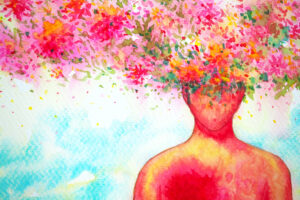In the last decade, rates of anxiety, stress, and depression have increased to unprecedented levels, especially among college students. As a result, colleges and universities — including UW–Madison — are working harder than ever to encourage and ensure student well-being. Angela Barian writes about the Art and Science of Human Flourishing course at UW-Madison, and the additional resources available to UW-Madison students to promote well-being.

Every fall, John Dunne asks his students to visualize a strawberry.
Dunne, the Distinguished Chair in Contemplative Humanities through UW–Madison’s Center for Healthy Minds, teaches a course for first-year students called, “The Art and Science of Human Flourishing.” The course integrates extracurricular learning experiences with classroom work to help give students the ingredients to explore well-being. In that course, he does the strawberry exercise.
“If you visualize a strawberry hard enough — delicious, freshly washed, organic, from Whole Foods, a little chocolate sauce nearby — your mouth starts to water,” Dunne says. “But why does it do that? There is no strawberry.” Dunne explains that one of the things that makes humans unique is our ability to simulate experience in ways other animals cannot. That simulation is so intense that it feels real to us, in both mind and body. “It’s not just mental, it’s physical too,” Dunne says. “So, if I think about a strawberry, even though there’s no strawberry here, my mouth waters. Because in my mind, there is a strawberry. And that’s causing my body to react.”
Researchers call this cognitive fusion: “In other words, we tend to fuse our thoughts with our experiences. We think our thoughts are reality, and the more real they appear to us, the more of a physiological effect they have.” And Dunne says that this phenomenon can be a major contributor to anxiety and stress: just visualize taking the toughest, most important test of your life, and feel your heart race. “But it’s a thought,” Dunne says. “It’s not a strawberry.” Dunne argues that students’ ability to recognize that it’s not a strawberry — or more to the point, that this test will not actually kill you — is key to managing stress and anxiety.
And if you go by statistics, it seems students could use this lesson more than ever.
A Student Mental Health ‘Crisis?’
America, it appears, is in a state of panic. From the elderly to kindergartners, rates of anxiety (and its frequent companion, depression) have increased dramatically. And college students in particular are feeling the squeeze of a stressed-out society: According to the Association for University and College Counseling Center Directors, 60% of students report experiencing “overwhelming” anxiety, and 40% felt so depressed they had difficulty functioning. Mental health and well-being are among the top concerns on college campuses around the country, and for good reason. Researchers and the UW experts we spoke with agree that this is indeed cause for concern.
“It’s not just here,” says Dunne. “I’ve been to a few places to talk about our work and the crisis is evident everywhere. And I would absolutely call it that — a crisis.” Dunne cites a number of studies showing steady increases in anxiety among college students. “You also see gradual increases in medication use,” Dunne says. “So much so that when you arrive on the college campus, the number of students who are taking or have taken a medication is one in three.”
Scott Anderson, a graduate student in UW’s Department of Kinesiology and teaching assistant in “The Art and Science of Human Flourishing,” stresses the breadth and severity of the problem: “We’re not talking about the kind of anxiety where you just don’t feel comfortable. We’re talking about anxiety that’s considered a disability in some cases. And that’s wreaking havoc with institutions, how we accommodate people, help them to get the education they want to get. So we really do have a crisis.”
An Age of Distraction — and Pressure
How did we get here? And how did it get this bad? One of the reasons college students in particular are struggling with their mental health may be an outgrowth of the qualities that got them into college in the first place, like tenacity, persistence, and high standards. “UW students are here because they are stellar at learning and thinking,” says Tamar Kelson, a senior psychologist and wellness provider at University Health Services. “We have a very talented, intelligent student body. At the same time, I’ve noticed that students often motivate themselves through an inherent threat: If I don’t study, I will fail. If I don’t do well, I won’t get into medical school. I’ve got to do well. There’s a lot of judgment, perfectionism, and worry there. People often hold a self-critical voice, because they believe that if they don’t, they won’t be successful.” In response, Kelson encourages self-compassion. “What you say to yourself should be at least as kind and as gentle as what you would say to a good friend or loved one.”
To illustrate another reason, Dunne pulls up a graph from The Association for University and College Counseling Center Directors Annual Survey. The rate is unmistakably rising — with a notable spike around 2009–10. “This is key,” Dunne says. “Something has happened right around here. And one of the things that happened was the iPhone, with accessibility to social media.” As Dunne notes, studies show that the widespread use of social media has mental health effects. Dunne argues that as a result, students “get locked in, especially in the culture of the digital world, into a disembodied culture focused around tiny screens that inevitably block the larger experience of the environment. This lack of social connectivity makes students more vulnerable, especially when they face the kinds of social threat—which is mostly about exclusion—that they encounter on social media. Social threat on social media can include outright cyber-bullying, but it can also just amount to worries about not being ‘liked’ enough, or being left out in some way.”
Social connectivity allows us to better handle social threat, Dunne says: “One of the hypotheses about ‘what’s happening with young people today’ has to do with social exclusion. Imagine a band of humans living on the savannah tens of thousands of years ago. If you’re excluded from that group, you’re dead. You can’t survive on your own, and there isn’t some other human band you can just walk to and join. So humans are primed to see social exclusion like a death threat. Social threat can be very hard to handle if one does not have authentic social connection with supportive peers.”
Excessive use of devices also increases distraction, which has negative effects on well-being. Dunne cites a study from Harvard University that tested this idea: “In the study, people are ‘pinged’ at various times during the day,” says Dunne. “Some of the basic questions they were asked were, are you paying attention to what you’re doing, or not? and are you enjoying yourself? 47% of the time, people are distracted. And distraction correlates with not enjoying what’s going on. So we do seem to live in an age of distraction.”
Kelson agrees, but adds that we can leverage the widespread use of technology to help students cope: “I think a lot of us are tied to our phones, and it contributes to overall stress, but many students find meditation apps helpful. I think there is value in recognizing, this is the mode they use. Why not say to them, can you balance your digital time with something that can help you cope better with stress?” Kelson suggests SilverCloud, an online self-guided mental health resource that has been developed through UHS and is available to all UW–Madison students.
The UW–Madison Approach: Comprehensive, Multi-Faceted
So, what is UW–Madison doing to address this crisis? Like many universities, the UW is addressing student well-being in multiple ways.
Increasing Mental Health Care Providers
In February 2019, Vice Chancellor for Student Affairs Lori Reesor and former Provost Sarah Mangelsdorf commissioned the creation of a mental health task force. The task force, created to, “address concerns from students, faculty, and staff about the well-being of UW students,” released a report this past May. Since the release of the report, University Health Services hired 13 new mental health providers, including providers with a focus on students of color, LGBTQ+ students, and additional Spanish-speaking providers. Through December 20th, Mental Health Services will offer extended evening hours, staying open on Mondays and Tuesdays until 7 p.m.
Fostering Well-Being from the Classroom
UW is also addressing the crisis right inside the curriculum. Dunne’s course — the one with the strawberry exercise — was designed specifically to address the surge in anxiety and depression among college students. “The idea was to create a course that really would, in a sense, give students the ingredients for flourishing: what do we think are the skills and knowledge that will help a student to lead a good life?” Dunne says.
Center for Healthy Minds Founder, and William James & Vilas Professor of Psychology and Psychiatry Richie Davidson also teaches in the course. “It’s an unbelievable opportunity for an undergraduate to have that exposure to him,” says Susan Huber Miller, Director of Academic & Continuing Education Programs at the Center for Healthy Minds. Dunne and Huber Miller say preliminary research shows that students who take the course show significant statistical improvements in feelings of anxiety, depression, resilience, connection, and roommate issues. “It’s really helping them navigate so many of the things that are thrown at them,” Huber Miller says.
Harnessing the Power of Technology
This fall, in conjunction with the course, the UW introduced the Healthy Minds app. The app leverages the Center’s research to teach the science of well-being, help foster daily habits that encourage healthy minds, and provide tools to track progress and measure well-being. Students in Dunne’s course use the app both inside and outside of class, but the Center has made a version available to everyone. “In the future, we’re looking forward to creating a customized version of the app for UW,” Dunne says.
Supporting the Body-Mind Connection
UW experts also note that recreation, exercise, and play are essential to well-being. University Recreation and Wellbeing, which used to be Rec Sport, rebranded this past August to reflect the wide array of well-being activities they currently offer and are planning to include in the future. Their mission, “play hard, get fit, live well,” engages both body and mind. “We just want to support students living well on campus, so when they graduate, they know how to take care of themselves in the way they need to,” says Lauren DeCarolis, Assistant Director of Strategic Engagement at Rec Well.
Abby Diehl, Assistant Director of Wellbeing at Rec Well, agrees: “What we emphasize is that well-being is individualized for students. All of their perspectives are different. All of their needs are different. So we try to be intentional, knowing that, for example, cycling is not for everyone. We offer many different programs for students to find their niche.” All students are automatically members of Rec Well — they just need their WisCard to enter facilities, and can enter whenever they’re open. “But students don’t have to come to our facilities to live well,” DeCarolis says. “If that means walking instead of taking the bus, taking 30 minutes out of your week to meditate or journal, or just get lunch with a friend — wellness can mean so many different things.” Diehl adds, “We’re more than a building; we’re building a movement.”
Providing Opportunities to Connect, Learn, and Reflect
Social engagement and skills enrichment are also ways students can alleviate stress. The Wisconsin Union hosts 2,300 events every year that provide students opportunities to take time away from daily difficulties. Most of the Union’s events and groups are run by students. “For example, Hoofers hosts outdoor rec skiing at resorts in the area, and for those who’d rather stay inside, Wheelhouse Studios offers all sorts of arts activities and creative spaces throughout the year,” says Shauna Breneman, Communications Director for the Wisconsin Union. “The Wisconsin Union believes that wellness stems from the body and mind. We provide multiple ways for students and the community to access these wellness events. In addition to students’ studies, they need to take time away to have fun and learn, just for the sake of having fun and learning. They need time and space to invest in themselves outside the classroom,” Breneman says. In addition to the Hoofers activities and the Wheelhouse Studios, Union South added a Reflection Room in 2016. This room provides a space to relax or engage in reflection and enjoy the peace and quiet in the ways people find most helpful.
Expanding Access to Group Counseling
If UW students think that a group support setting may help them, they have options: Kelson notes that UHS provides a group counseling schedule online where students can check out support groups, wellness workshops, skill-building groups, and interpersonal process groups. She adds that her newest group takes a unique, fun approach: “It’s called, ‘Mindfully Laugh Out Loud,’ and it promotes laughter as an approach to mental health and stress management.” Kelson leads multiple groups on mindfulness techniques and strategies. Some of them require a quick intake, but many are “just call and sign-up,” Kelson says.
It’s Not a Strawberry
Parents of college students are in a unique situation with regard to intervention. How do parents know when and how much to intervene if they suspect their student may need help? Kelson says she can relate: “I’m a parent of a college student, and I know how hard it is,” she says, with a laugh. “It is difficult letting go of control as a parent and letting your young adult student develop their own strategies for coping. Sometimes, waiting for them to come to you and say, I’m really stressed, or this is so difficult, is the way to go. Then you have an opening to provide support.”
Additionally, parents need to take care of themselves. After all, there’s plenty of research indicating that parents are also stressed and anxious. For parents, too, UW experts are here to help: One technique Kelson teaches helps connect the mind and body in stressful moments: “If you’re feeling anxiety, you can engage your senses to help alleviate it. This mindfulness activity involves tuning in and naming five things you can see, four things you can hear, three things you can touch, two things you can smell, and one thing you can taste.” Kelson says, “that anxiety, it doesn’t exist at the forefront when you are mindfully engaging in the present moment with things that are in your senses and the environment.”
Remember, it’s not a strawberry.
Additional Resources for UW-Madison Students
- “Relaxing with Rob:” This podcast, hosted by recently retired (and much-beloved) UHS counselor Rob Sepich, explores strategies to reduce stress and increase mindfulness.
- Outdoor UW Rentals and Yoga Classes: All year long, Outdoor UW offers outdoor rentals ranging from kayaks to snowshoes to help the community and visitors get outside for some relaxation and recreation. The team also offers all-level yoga class year-round, including outdoor classes on the Terrace during the summer.
- Adventures with the Wisconsin Hoofers: With 2,000 members and growing, adventures abound with the Wisconsin Hoofers. And wellness is built right into the fun thanks to year-round activities with the Hoofers’ six outdoor clubs.
- Reflection Room: On the third floor of Union South is a reflection room, which was created by the Wisconsin Union in collaboration with multiple student organizations, staff, students and faculty. The team created this space as a place of retreat where community members can enjoy peace and quiet amid the busy humming of campus.
- Creating with Wheelhouse Studios: Ease stress and anxiety through the arts at Wheelhouse Studios at Memorial Union. Studies have shown that art can have a powerfully positive impact on health, including reducing levels of the stress hormone cortisol and improving mood. Wheelhouse offers dozens of classes throughout the year, three workspaces and drop-in art opportunities.
- Climb or Bowl with Sett Recreation: Build muscle and endurance by climbing Sett Recreation’s indoor, multi-story climbing wall. The wall’s routes change regularly and include routes for many skill levels. Within the same space, Sett Recreation visitors can bowl, which exercises the lower bod and stimulates mental alertness.
- Free Group Fitness Classes at Rec Well: While some group fitness classes usually incur a minor fee, during finals week Rec Well is offering them free. The free group classes begin on December 12th, this semester’s Study Day.
- The Gift of a Personal Training Session: From Abby at Rec Well: “Especially for parents, sometimes a nice holiday gift is a personal training session. That way, the personal trainer can really see what their interests are. And that’s a one-on-one connection they can make with someone to help them build a physical activity plan that they might never have had before. It’s an opportunity for students to find what fits for them.”
- Rec Well’s “Roll Into Finals:” This “self-care study break” is hosted in the pool in the Natatorium. There will be log rolling, a giant inflatable obstacle course in the pool, a cannonball contest, and plenty of activities on deck for those who don’t want to get wet, including cornhole, ping pong, Rec Well swag, and food giveaways.
- SilverCloud is an online self-guided mental health resource for stress, anxiety, depression and body image. It is available 24 hours a day.
-Angela Barian






